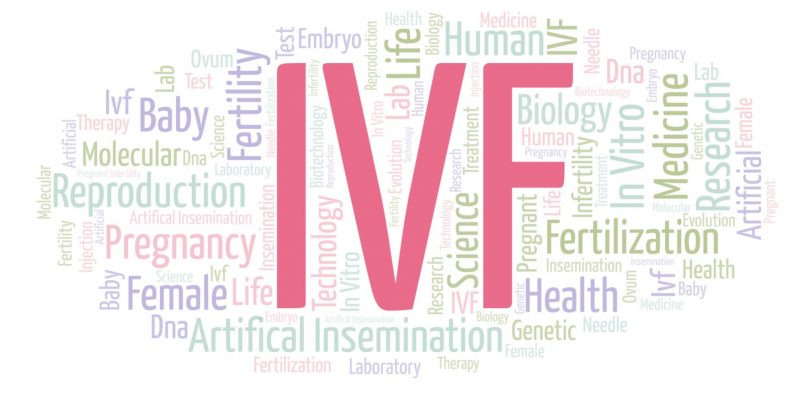While the majority of patients who see a fertility specialist are able to achieve pregnancy with medication therapy or surgical procedures, there are others patients who require more advanced reproductive technologies like in vitro fertilization (IVF). Whether you’re dealing with male factor infertility, endometriosis, damaged fallopian tubes, unexplained infertility, or ovulatory dysfunction, there’s a good chance that IVF is the next best step for you.
Of course, when it’s time to really consider IVF, most patients have plenty of questions. That’s why we want to help you get those questions answered so that you can be knowledgeable on the process and know what to expect before taking the next step.
In vitro fertilization: How does it work?
With in vitro fertilization, the fertilization of the egg and growing of embryos occurs outside the body, and then the embryo is transferred into the uterus. In order to do this, the eggs and sperm are combined in a laboratory and allowed to grow (culture) for 3 to 5 days before the embryo or embryos are transferred to the woman’s uterus with the goal of implantation.
IVF includes 6 main steps:
Step #1: Ovarian suppression. In order to maximize the number of eggs grown, control the growth of these eggs and prevent early ovulation, we often utilize 2-4 weeks of either an oral contraceptive pill or daily injection called Lupron, before we move on to step #2.
Step #2: Stimulation period. During this time, the woman takes fertility medications (2-3 injections a day for 8-12 days) with the goal of developing several mature eggs that are ready for fertilization.
Step #3: Egg retrieval. During a minor surgical procedure done at the doctor’s office, these mature eggs will be retrieved from the ovary.
Step #4 Fertilization. The eggs are then mixed with the sperm in the laboratory where the sperm will fertilize the eggs and form embryos. If the sperm is of poor quality, intracytoplasmic sperm injection (ICSI) may be used where the sperm is injected directly into the egg.
Step #5: Embryo culture. During spontaneous conception (ie NOT IVF) the 5-6 days that the embryo travels down the fallopian tube to the uterine cavity are vitally important. The embryo goes from a two-cell embryo to a 200+ cell embryo, and one that is able to implant. During IVF, the same 5-6 days are needed to identify the best embryo(s) for transfer.
Step 6: Decision… At the blastocyst stage (5th to 6th day after fertilization), your physician may recommend one of the following options:
-Embryo transfer, where the embryo(s) are placed into the uterine cavity
-Cryopreservation (also known as a freeze all), where the viable embryos are frozen to allow for healing of the ovaries and uterus prior to embryo transfer
-Embryo biopsy (PGS, PGT-A, PGT-M), where a few cells from the outside of the embryo are removed and sent off for testing and the embryo is frozen. This allows us to identify the healthiest embryos for transfer.
Additional decisions you may face
While deciding to go forward with IVF is the first major decision, there are a few more decisions you might have to make after that. These include:
Should you use donor eggs? For women who are over 40 or have had radiation or chemotherapy for cancer treatment, using donor eggs can greatly increase the chances of a successful IVF cycle.
Should you undergo ICSI? ICSI, intra-cytoplasmic sperm injection, is indicated for patients with poor sperm quality or low sperm numbers. We often recommend it in cases of unexplained infertility.
Should you do a fresh or frozen transfer? With a fresh embryo transfer, the embryos are transferred 3 to 5 days after retrieval; though for women with endometriosis, PCOS, or other condition, frozen embryo transfers have shown to have a greater rate of success.
Should you opt for embryo biopsy? On the 5th or 6th day, the embryologist takes a few cells from the outside of the embryo and sends them off for genetic testing. The embryo is frozen at Alabama Fertility. This testing is recommended for couples over the age of 35, those with prior IVF failure, or recurrent pregnancy loss.
The cost of treatment and making the decision to go forward with IVF
The average cost of IVF is between $10 – $15,000, and even though the procedure itself is not covered by most Alabama-based insurance carriers, you’ll want to contact your insurance company directly to see if they offer any fertility benefits.
Luckily, insurance isn’t the only place to turn. While some fertility specialists, such as Alabama Fertility, offer a shared risk program and a progressive discount on each IVF cycle, there are also a handful of financial institutions that provide loans for fertility treatments.
Making the decision to move forward with IVF is personal, but once you’ve decided that IVF is the best option to give you your little bundle of joy, simply knowing what to expect can make a world of difference.
As a treatment that has worked for so many, (you can find success stories everywhere online, including our blog), it may just bring you and your partner the child for which you’ve been longing.
Learn more about in vitro fertilization from Alabama Fertility in Birmingham, AL
Is in vitro fertilization right for you? Please feel free to contact us for further information.
